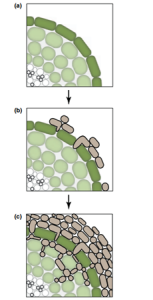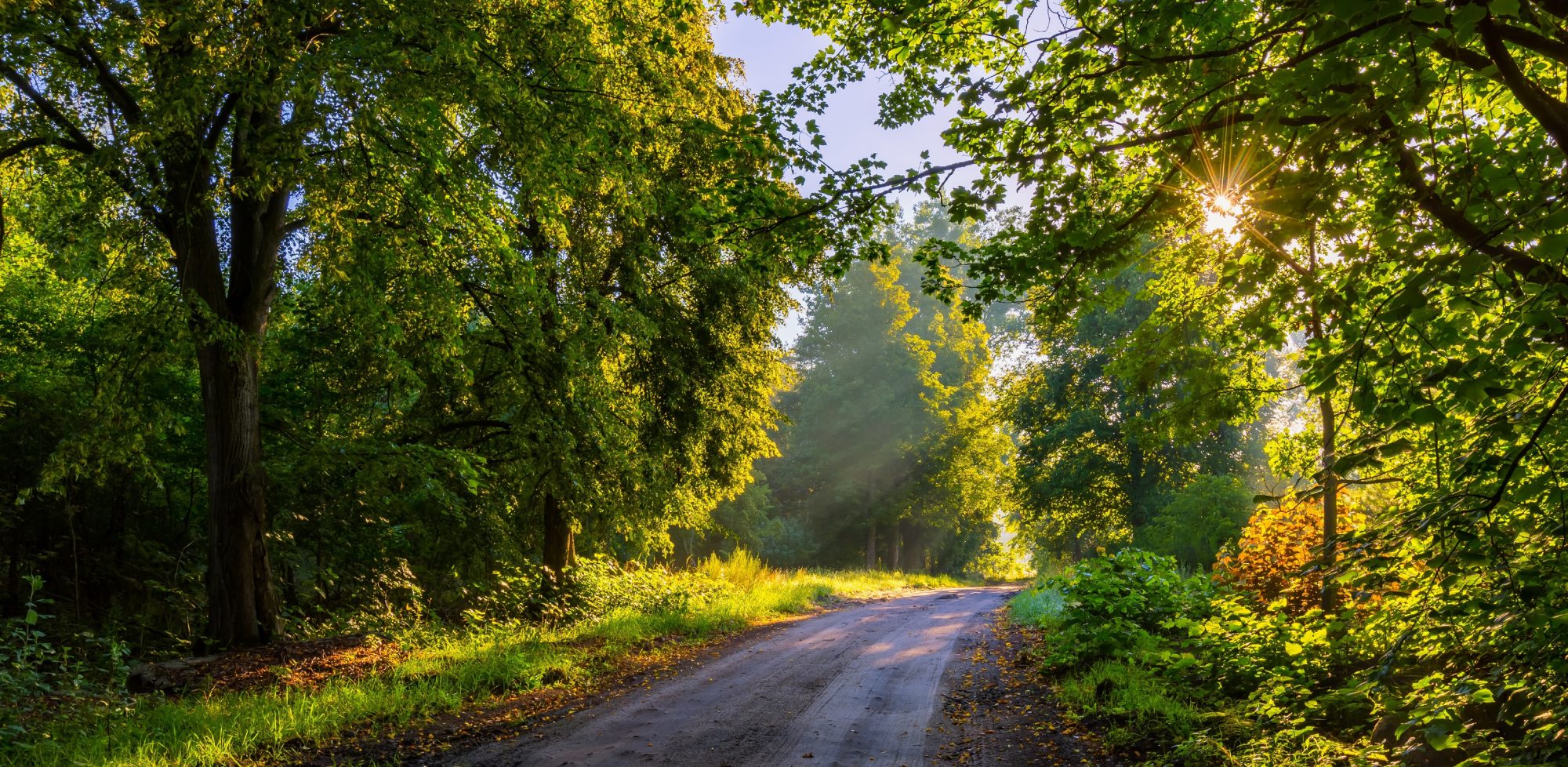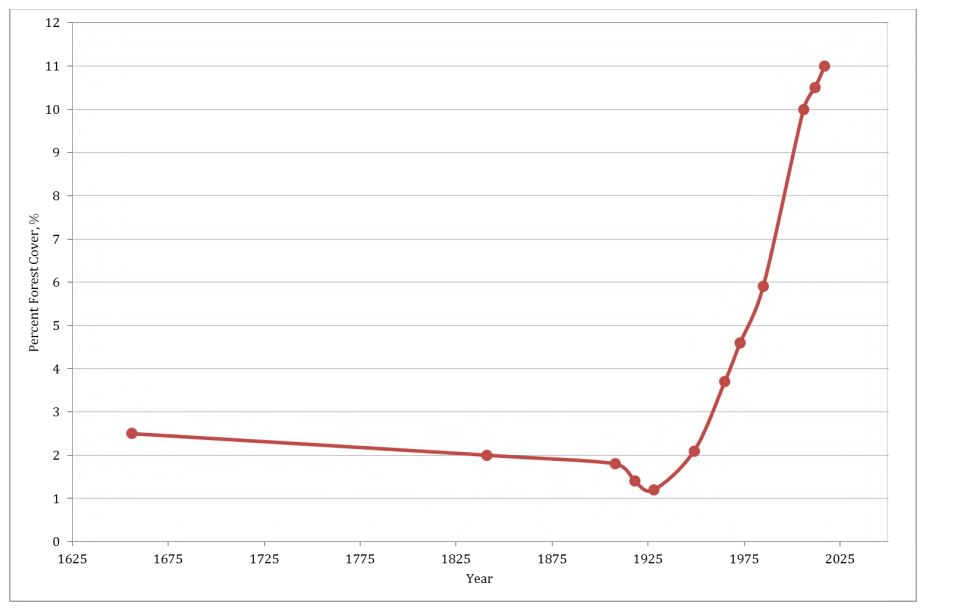Nature Based Solutions: Afforestation with Rhizocore – by Kathleen Conroy & Declan Little MCIEEM
This blog has been written in conjunction with CIEEM’s upcoming Irish Conference: Delivering a Nature Positive Ireland.
The Nature Trust is an Irish not-for-profit creating new native Irish woodlands and restoring natural habitats to make a positive long-term impact on biodiversity and climate while providing valuable public amenities across the country. The Nature Trust works with leading professionals in the areas of forestry and ecology to ensure best-in-class nature-based projects.
The Nature Trust is teaming up with the Scotland-based start-up company Rhizocore Technologies for a number of native woodland afforestation projects. Rhizocore develops mycorrhizal fungi pellets which have been shown to positively impact tree growth and development. After the purchase of agricultural land in County Mayo, The Nature Trust developed experimental plots with Rhizocore for this site. These plots will be used to understand the role of ectomycorrhizal fungi in assisting native woodland afforestation and how Rhizocore’s nature-based solution can help Ireland attain national forestry targets.
Forestry in Ireland
Forest cover is approximately 11% of Ireland’s total land area (DAFM 2020). This is the highest forest cover in centuries for this small island nation (Figure 1). Years of clearing the land for agriculture, especially pasture, has drastically reduced and kept forest cover to a minimum. At its lowest point, Ireland had only 1% forest cover at the turn of the 19th century. However, in the past century, there was an increasing understanding for the need for greater forest areas. With a number of state funded schemes and programmes to promote forestry, the Irish government aspires to reach 18% forest cover by 2050 (DAFM 2015). To reach this goal, Ireland must have a sustained afforestation programme. As a considerable portion of land has not had forest cover for centuries and are located at exposed western locations, it can be difficult to establish trees in these environments. These sites lack tree mycorrhizae and are thus the focus of this project.
Mycorrhizal Fungi

Figure 2. ECM association between root (green cells) and fungus (brown cells) (Plett and Martin 2010).
Often overlooked and in some instances viewed upon negatively in forestry (e.g., honey fungus ability to kill trees), fungi provide essential services with regards to health, maintenance, and structure of all ecosystems, especially forests. The Fungi Kingdom consists of a vast array of different species most notably yeasts, moulds, and mushrooms. This Kingdom is large with estimates of 5.1 million fungi species, however, only a small percentage of those have been recorded and described (Blackwell 2011). Fungi species perform many essential processes including organic matter decomposition (e.g., leaves, branches, wood, decomposing animals and invertebrates) and nutrient cycling. The ectomycorrhizal (ECM) fungi that we will be discussing today create (mostly) mutually beneficial symbiotic relationships with trees. This relationship is called mycorrhizae and it is formed by plant roots and a fungus (Dighton 2009) (Figure 2).
A mycorrhizal relationship is advantageous, because the fungi receive carbohydrates from the tree and the tree receives nutrients (i.e., phosphorous and nitrogen) from the fungi. Plants can receive up to 80% of their nitrogen and 70% of their phosphorous from mycorrhizae (Van Der Heijden, Bardgett, and Van Straalen, 2008). Due to their network of mycelium (which act in a similar manner to plant roots), fungi can access reservoirs of nutrients that are inaccessible to trees. These networks are also used to share nutrients between different individual organisms (i.e., trees). Mycorrhiza appears in seven forms: arbuscular-, ecto-, ectendo-, arbutoid, monotropoid-, ericoid and orchid mycorrhiza (Smith & Reed 2008) and the classification is largely attributed to the fungus involved. A tree species can have different mycorrhizae depending on its life history or current environmental conditions (Holste et al. 2016), and some trees can have many mycorrhizae at once (Smith & Reed 2008). A tree may have associations with several thousand fungi individuals concurrently (Smith & Reed 2008).
Although not exclusive to trees, ectomycorrhiza occur with woody plants, including many shrubs (Smith & Reed 2008). There are an estimated 5,000-6,000 fungi species that form ectomycorrhiza (Molina et al.1992); this number is constantly changing as we develop a better understanding of ECM interactions. An example of a common ECM fungal family would be ascomycetes, most notably the widespread Cenoccum geophilum (Smith & Reed 2008). Even Tuber melanosporum (black truffle, a delicacy used in cuisine) is an ECM fungus (Smith & Reed 2008). Many ECM fungi have the ability to fix nitrogen and so they are essential in ecosystem that are nitrogen limited. Even though most ECM fungi species are not species specific with their associations, ECM fungi do show ecosystem preferences being more abundant and diverse in forests than in agricultural fields (Liang et al. 2020, Liu et al. 2020).
Due to the nature of their relationship, ECM fungi cannot survive without trees. Some examples of tree families that make ECM associations include willow, pine, birch, and hazel. Naturally, ECM fungi re-establishment in an afforested area would happen either through existing extensive mycelium exploration from a neighbouring woodland or via transportation to the area. These networks greatly improve the success of establishing forests. Ectomycorrhizal networks have been found to improve sapling growth and strength against different pressures (i.e., disease and pests) (Liang et al. 2020). These networks connect the different trees in a forest and move nutrients between them (Smith & Reed 2008).

Rhizocore Technologies
Rhizocore work to remove the years that are required for ECM to become established in an area where they are scarce. Their technique centre around creating pellets from locally collected fungi. They collect fruiting bodies from similar woodland communities that are being established on green field sites. These fungi are placed in ideal laboratory conditions where they can replicate. Pellets are created that are subsequently put into the ground along with a young tree during planting. Ectomycorrhizal networks are formed between the pellet mycorrhizae and the tree roots. The hypothesis is that trees that receive the pellets will grow faster and stronger than trees that do not receive pellets. This will be tested at field scale where blocks of trees will receive pellets (treatment) while adjacent blocks will not (controls). The trees involved are sessile oak, Scots pine, willow, and downy birch.
Dr Ciarán Fallon from Collite Nature and The Nature Trust will be speaking about this more at our upcoming Irish Conference: Delivering a Nature Positive Ireland.
References
Blackwell, M., 2011. The Fungi: 1, 2, 3… 5.1 million species?. American journal of botany, 98(3), pp.426-438.
Department of Agriculture, Food and the Marine. 2015. Forestry Programme 2014-2020 Ireland. DAFM, Johnstown Castle Estate, Co. Wexford.
Department of Agriculture, Food and the Marine. 2020. Forest Statistics Ireland 2020. DAFM, Johnstown Castle Estate, Co. Wexford.
Dighton, J 2009, Mycorrhizae. in Encyclopedia of Microbiology. Elsevier Inc., pp. 153-162. https://doi.org/10.1016/B978-012373944-5.00327-8
Holste, E. K., Kobe, R. K. & Gehring, C. A. 2017. Plant species differ in early seedling growth and tissue nutrient responses to arbuscular and ectomycorrhizal fungi. Mycorrhiza, 27, 211-223.
Liang, M., Johnson, D., Burslem, D. F. R. P., Yu, S., Fang, M., Taylor, J. D., Taylor, A. F. S., Helgason, T. & Liu, X. 2020. Soil fungal networks maintain local dominance of ectomycorrhizal trees. Nature Communications, 11, 2636.
Liu, J., Le, T. H., Zhu, H., Yao, Y., Zhu, H., Cao, Y. & Zhao, Z. 2020. Afforestation of cropland fundamentally alters the soil fungal community. Plant and Soil, 457, 279-292.
Molina R, Massicotte H, Trappe JM 1992 Specificity phenomena in mycorrhizal symbiosis: community ecological consequences and practical application. In Mycorrhizal Functioning. Ed. MF Allen pp. 357–423. Chapman and Hall, New York, USA.
Plett, J. M. And Martin, F. 2011. Blurred boundaries: lifestyle lessons from ectomycorrhizal fungal genomes. Trends in Genetics, 27, 14-22.
Smith, S.E. and Read, D.J., 2008. Mycorrhizal symbiosis. Academic press.
Van Der Heijden, M.G., Bardgett, R.D. and Van Straalen, N.M., 2008. The unseen majority: soil microbes as drivers of plant diversity and productivity in terrestrial ecosystems. Ecology letters, 11(3), pp.296-310.
Blog posts on the CIEEM website are the views and opinions of the author(s) credited. They do not necessarily represent the views or position of CIEEM. The CIEEM blog is intended to be a space in which we publish thought-provoking and discussion-stimulating articles. If you’d like to write a blog sharing your own experiences or views, we’d love to hear from you at SophieLowe@cieem.net.

